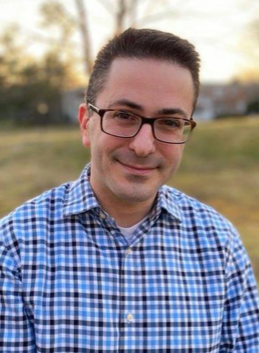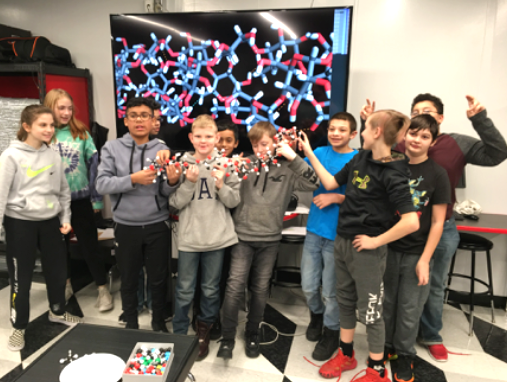Education Corner
Embedding Biomolecular Modeling in Elementary and Middle School Curriculum
by Daniel Fried, Ph.D., Saint Peter’s University, Jersey City, New Jersey

Daniel Fried, Ph.D.
Daniel Fried is an Assistant Professor of Chemistry at Saint Peter’s University, Jersey City, New Jersey. He is also the creator of Biochemistry Literacy for Kids, which brings high-level chemistry and biochemistry to kids, starting in elementary school. Dr. Fried has a B.S. in Biochemistry from Binghamton University and a Ph.D. in Chemistry from Yale University. He also did post doctoral work at The Weizmann Institute of Science. For more information see BiochemistryLiteracyForKids.com.
Kids have a natural enthusiasm to ask questions about science, especially in their early years. As educators, we can strive to give kids every opportunity to learn about as many areas of science as possible, but advanced subjects like biochemistry are usually difficult to include in elementary and junior high, despite their incredible power to explain how the living world works—and to answer the questions that kids ask.
Unfortunately, most teachers are not trained in biochemistry or molecular modeling, so they may not be comfortable designing lessons about the subject. Administrators may also be wary of taking time away from preparation for standardized tests. To make biochemistry attractive to schools, we need to show that it is highly motivational for students, easy for instructors to teach, and supportive of the standards-based curriculum. I believed that biochemistry is all of these, especially when combined with molecular modeling activities, so I created Biochemistry Literacy for Kids—a fun and interactive digital curriculum that allows kids to easily gain a much deeper understanding of biology and chemistry (1). It gives teachers confidence to engage in high-level science discussions (2), and fast-tracks kids to college-level learning that also augments standard-based curricula.
Since 2018, close collaborations with three New Jersey schools have given students long-term access to biochemistry learning. At these schools, Biochemistry Literacy was much more than a one-time enrichment activity, but actually was embedded in the curriculum to form an integral part of the school-year for students. With the help of molecular modeling, students learned materials usually reserved for college courses, and the milestones achieved by the students were a source of pride for students, teachers, parents, and administrators. I hope that other academics might use these experiences as a model to deploy similar kinds of high-level STEM learning programs.
Alexander D. Sullivan Elementary in Jersey City
Over 7 weekly sessions, three classes, one each from third, fourth, and fifth grade, participated in a modeling-based biochemistry learning program. In the introductory lesson, students used PyMol to explore the 3D structure of hemoglobin. The main goal of this introductory lesson is not to convey protein secondary structure or function, but to find the patterns of covalent bonding. Students discover for themselves that carbons have four bonds, that hydrogens have one bond, for example. They also notice that the pattern double-bonded-carbon/carbon/nitrogen is quite common and that there are some carbon rings with alternating double and single bonds, but that all the carbons have a total of four bonds. This introductory “molecular field trip” sparks curiosity about the molecular world and empowers students, since they discover patterns of nature themselves, rather than being told about them. The second part of this introductory lesson is a tactile model-building exercise where students apply the bonding patterns learned in the PyMol learning environment. They use MolyMod model kits to build small gas molecules like oxygen gas, nitrogen gas, and carbon dioxide. They then reexamine the PyMol structure to find the oxygen gas molecules bound to the heme irons, and view animations showing how oxygen binds and unbinds to the heme. The presentation, video narration, modeling files, and student worksheets are freely available at BiochemistryLiteracyForKids.com.
Subsequent lessons from this program employed a similar blend of molecular modeling, animated presentations, and tactile model building. Students learned how the periodic table can be used to derive Lewis dot structures, and within a few lessons, students began learning about acids, bases, and amino acids. The program culminated with a class-wide peptide building exercise in which students perform a dehydration reaction on dozens of amino acid models to create an extremely long peptide. Students now could reflect on patterns they noticed in the initial PyMol activity, and discover the origin of the peptide backbone pattern and the concept of the amino acid side chain. The school administration later included Biochemistry Literacy classes as part of a demonstration day for a delegation of educators visiting from China (Figure 1).
Hopatcong Middle School in Hopatcong
Over the past two years, two sixth grade teachers have taught a special STEM elective class that includes Makerspace activities and the Biochemistry Literacy curriculum. Twelve class sections for a total of160 students have participated since inception. Giving students long-term access to MolyMod model building, PyMol computer modeling, and the Biochemistry Literacy curriculum has instilled a strong interest in the subject, and the elective is in high demand among students. I recently visited an advanced class at the school, and was extremely impressed by how well the students had learned the material under the guidance of their teacher, Jim McKowen. During my visit, students participated in a lesson about the structure of glucose, including the nature of the anomeric carbon, and in a similar manner to the peptide building activity described above, students created a very long amylose polymer (Figure 2). My collaboration with Hopatcong Middle School was recently featured in the Education section of The New York Times.
Hudson Montessori School in Jersey City
Throughout the 2019-2020 school year, I have led weekly classes in a fourth and a mixed fifth/sixth grade class, in collaboration with several teachers and undergraduate students. This school has generously given me the opportunity to develop and pilot new lessons on digital molecular modeling, model building, and other topics. As part of the program, I created several kid-friendly protocols for retrieving files from the Protein Data Bank, and rendering them in PyMol (Figures 3-4). These protocols are available to anyone on the project website. Some of the protocols are briefly described below.
DNA binding and the effect of a mutation: Students render the p53 tetramer bound to the p21 promoter sequence (PDB ID 3TS8) and use PyMol’s mutagenesis tool to investigate how point mutations may affect the structure and DNA binding ability of the protein (3, 4).
Turning off inflammation with aspirin: Students render cyclooxygenase that has been modified by aspirin (PDB ID 1pth) to learn how a drug’s action works to block the enzyme’s ability to bind its substrate (5, 6).
How oxygen is carried by the blood: Students render the hemoglobin tetramer (PDB ID 1B86) and find the oxygen binding site on the four hemes (7, 8).
Build your own amino acid: Students use the building function of PyMol to construct a creative unnatural amino acid. They also use the sculpting function to learn about energy minimization and steric clash.
Teachers at the school have enhanced their activity-based learning by synchronizing with Biochemistry Literacy curriculum. For example, a water quality unit, which included sampling the nearby Hudson River, was augmented with student knowledge of the meaning of acid water and protonation, and students had experience studying the structures of several of the pollution molecules found in the water. Over the school year, students have engaged in many active learning projects using a variety of manipulatives (Figure 5). Students recently showcased their biochemistry literacy at their school Maker Faire, which included a large display of secondary structure dioramas modeled from PyMol, as well as models of the cell membrane with an embedded acetylcholine receptor (Figure 6). During a presentation for parents and siblings, students modeled sodium ions with purple beads flowing through the receptor, and taught the audience about hydrogen bonding of the alpha helix and beta sheet (Figure 7).
Giving students long-term experience with tools like the Protein Data Bank and molecular modeling software can build mastery of topics that are typically not found in elementary or middle school, or even in high school. These early, extended experiences with high-level learning have the potential to change the career trajectories of young students. For these students, biochemistry has become a normal and expected part of the school day, and a PDB structure loaded in PyMol, is just another tool for understanding their world.
Figure 4. A student and teacher at Hudson Montessori School using PyMol to render a hemoglobin crystal structure
Figure 6. Display of student-rendered PyMol images and protein dioramas at a the Hudson Montessori School maker faire. Students created secondary structure models and membrane-embedded acetylcholine receptor models from recycled materials.
Citations
- Fried, D. B., Tinio, P., Paneque, D., Hughes, A. Elementary student achievement and teacher perception of advanced chemistry curriculum European Journal of Science and Mathematics Education 2019 7, 37-148
- Fried, D. B., Tinio, P., Gumi, A., Gaffney, J. P. Enhancing elementary science learning through organic chemistry modeling and visualization, European Journal of Science and Mathematics Education 2019 7, 73-82
- PDB-101 Molecule of the Month on p53 Tumor Suppressor. doi:10.2210/rcsb_pdb/mom_2002_7
- Emamzadah, S., Tropia, L., and Halazonetis, T.D. “Crystal Structure of a Multidomain Human p53 Tetramer Bound to the Natural CDKN1A (p21) p53-Response Element.” Molecular Cancer Research 2011 9, 1493-1499.
- PDB-101“Cyclooxygenase”
- oll, P.J., Picot, D., Garavito, R.M. “The structural basis of aspirin activity inferred from the crystal structure of inactivated prostaglandin H2 synthase.” Nature Structural & Molecular Biology 1995 2, 637-643
- PDB-101 “Hemoglobin”
- Richard, V., Dodson, G.G., Mauguen, Y. “Human deoxyhaemoglobin-2,3-diphosphoglycerate complex low-salt structure at 2.5 A resolution.” Journal of Molecular Biology 1993 233, 270-274






